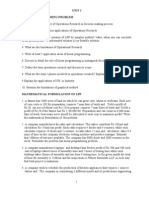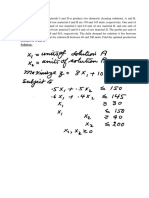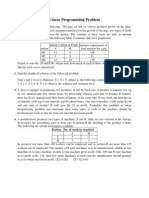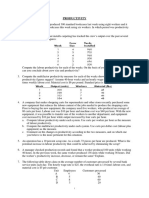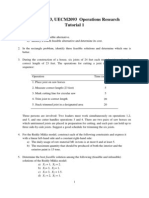OR - Assignment 1 Problem Formulation
Uploaded by
Sama AhmedOR - Assignment 1 Problem Formulation
Uploaded by
Sama AhmedAlexandria University Level 1
Faculty of Engineering First Semester
Production Engineering Department Operations Research 2024
Assignment 1: Problem Formulation
1. A company produces two types of product (Product I, and Product II). The two products
need manufacturing processes in three main plants (factories) A, B, and C. Each of the
products requires certain manufacturing time in each plant, and each plant has limited time
devoted for producing these two products. Data about processing times required by each
product in each plant, and about the time available in each plant are given below.
Time needed by each product Capacity
Plant in each plant (hours) available
Product I Product II (hours)
A 1 0 4
B 0 2 12
C 3 2 18
Unit profit $3 $5
The profit per unit of product I is $3, and that of product II is $5. Formulate the problem
as a linear programming model to find the optimum number of units produced from each
product so as to maximize the company's profit.
2. Nagaa Hammady manufactures aluminum sheets and aluminum bars. The maximum
production capacity is estimated at either 800 sheets or 600 bars per day. The maximum
daily demand is 550 sheets and 580 bars. The profit per ton is $40 per sheet and $35 per
bar. Formulate the problem as a linear programming model to determine the optimal daily
production mix.
3. A coffee packer blends Brazilian coffee and Colombian coffee to prepare two products:
Super and Deluxe brands. Each kilogram of Super coffee contains 0.5 kg of Brazilian coffee
and 0.5 kg of Colombian coffee, whereas each kilogram of Deluxe coffee contains 0.25 kg
of Brazilian coffee and 0.75 kg of Colombian coffee. The packer has 120 kg of Brazilian
coffee and 160 kg of Colombian coffee on hand. If the profit on each kilogram of Super
coffee is 20 cents and the profit on each kilogram of Deluxe coffee is 30 cents, formulate
the problem as a linear programming model to find how many kilograms of each type of
coffee should be blended to maximize profit.
4. XYZ Steel uses two scrap aluminum metals, A and B, to produce a special alloy. Scrap A
contains 6% aluminum, 3% silicon, and 4% carbon. Scrap B has 3% aluminum, 6% silicon,
and 3% carbon. The costs per ton for scraps A and B are $100 and $80, respectively. The
specifications of the special alloy require that (1) the aluminum content must be at least 3%
Operations Research Page 1 of 4
and at most 6%, (2) the silicon content must lie between 3% and 5%, and (3) the carbon
content must be between 3% and 7%. Formulate the problem as a linear programming
model to determine the optimum mix of the scraps that should be used in producing 1000
tons of the alloy.
Practice Problems
5. A container manufacturer is considering the purchase of two different types of cardboard-
folding machines: model A and model B. Model A can fold 30 boxes per minute and
requires 1 operator, whereas model B can fold 50 boxes per minute and requires 2 operators.
Suppose the manufacturer must fold at least 320 boxes per minute and cannot afford more
than 12 employees for the folding operation. If a model A machine costs $15,000 and a
model B machine costs $20,000, formulate the problem as a linear programming model to
find how many machines of each type should be bought to minimize the cost.
6. A furniture company manufactures four models of desks. Each desk is first constructed in
the carpentry shop and is next sent to the finishing shop, where it is varnished, waxed, and
polished. The number of man hours of labor required in each shop is as shown in the display
below.
Product Desk 1 (hrs) Desk 2 (hrs) Desk 3 (hrs) Desk 4 (hrs)
Carpentry Shop 4 9 7 10
Finishing Shop 1 1 3 40
Because of limitations in capacity of the plant, no more than 6,000 man hours can be
expected in the carpentry shop and 4,000 in the finishing shop in the next six months. The
profit (revenue minus labor costs) from the sale of each item is as follows:
Product Desk 1 Desk 2 Desk 3 Desk 4
Profit $12 $20 $18 $40
Operations Research Page 2 of 4
Assuming that raw materials and supplies are available in adequate supply and all desks
produced can be sold, the desk company wants to determine the optimal product mix, that
is, the quantities to make of each type product which will maximize profit. Formulate the
problem as a linear programming model to find the answer to the company’s question.
7. A farmer owns a farm that produces corn, soybeans, and oats. There are 12 acres of land
available for cultivation. Each crop that is planted has certain requirements for labor and
capital. These data along with the net profit figures are given in the accompanying table.
Labor (hr) Capital ($) Net profit ($)
Corn (per acre) 6 36 40
Soybeans (per acre) 6 24 30
Oats (per acre) 2 18 20
The farmer has $360 available for capital and knows that there are 48 hr available for
working these crops. Formulate the problem as a linear programming model to find how
much of each crop should be planted to maximize profit.
8. Pachin Company owns a small paint factory that produces both interior and exterior house
paints for wholesale distribution. Two basic raw materials, A and B, are used to manufacture
the paints. The maximum availability of A is 6 tons a day; that of B is 8 tons a day. The
daily requirements of the raw materials per ton of interior and exterior paints are
summarized in the following table.
% of raw material per ton of paint Maximum
availability
Exterior Interior
Raw material A 0.25 0.75 6
Raw material B 0.75 0.25 8
A market survey has established that the daily demand for the interior paint cannot exceed
that of exterior paint by more than 1 ton. The survey also shows that the maximum demand
for interior paint is limited to 2 tons daily. The wholesale price per ton is $3,000 for exterior
paint and $2,000 for interior paint. Formulate the problem as a linear programming model
to find how much interior and exterior paint the company should produce to maximize its
income.
9. In Metro supermarket, shelf space is limited and must be used effectively to increase profit.
Two tea items, Elgawhara and Lipton, compete for a total shelf space of 60 ft2. A box of
Elgawhara occupies 0.2 ft2 and a box of Lipton needs 0.4 ft2. The maximum daily demands
of Elgawhara and Lipton are 200 and 120 boxes, respectively. A box of Elgawhara nets
$1.00 in profit and a box of Lipton $1.35. Metro supermarket thinks that because the unit
profit of Lipton is 35% higher than that of Elgawhara, Lipton should be allocated 35% more
space than Elgawhara, which amounts to allocating about 57% to Lipton and 43% to
Operations Research Page 3 of 4
Elgawhara. Formulate the problem as a linear programming model to determine whether
Metro’s policy is the right one or not.
10. Exxon Mobil is building a refinery to produce four products: diesel, gasoline, lubricants,
and jet fuel. The minimum demand (in bbl/day) for each of these products is 14,000, 30,000,
10,000, and 8,000, respectively. Iran and Dubai are under contract to ship crude oil to Exxon
Mobil. Because of the production quotas specified by OPEC (Organization of Petroleum
Exporting Countries) the new refinery can receive at least 40% of its crude oil from Iran
and the remaining amount from Dubai. Exxon Mobil predicts that the demand and crude oil
quotas will remain steady over the next ten years.
The specifications of the two crude oils lead to different product mixes: One barrel of Iran
crude yields 0.2 bbl of diesel, 0.25 bbl of gasoline, 0.l bbl of lubricant, and 0.15 bbl of jet
fuel. The corresponding yields from Dubai crude are 0.1, 0.6, 0.15, and 0.1, respectively.
Exxon Mobil needs to determine the minimum capacity of the refinery (in bbl/day).
Formulate the problem as a linear programming model to help Exxon Mobil solve their
problem.
11. A progressive university has decided to keep its library open round the clock and gathered
that the following number of attendants is required to re-shelve the books:
Time of Day Minimum Number of
(hours) Attendants Required
0-4 4
4-8 7
8-12 8
12-16 9
16-20 14
20-24 3
If each attendant works eight consecutive hours per day (for example, the 1st shift is from 0
to 8, the 2nd shift is from 4 to 12, and so on), formulate the problem of finding the minimum
number of attendants necessary to satisfy the requirements above as a LP problem.
Operations Research Page 4 of 4
You might also like
- Thapar Institute of Engineering and Technology Patiala Optimization Methods (UMA-034)No ratings yetThapar Institute of Engineering and Technology Patiala Optimization Methods (UMA-034)2 pages
- Class Exercise On Linear Programming PDFNo ratings yetClass Exercise On Linear Programming PDF3 pages
- UECM2043, UECM2093 Operations Research Tutorial 10% (2)UECM2043, UECM2093 Operations Research Tutorial 15 pages
- Quantitative Analysis For BD Assignment.No ratings yetQuantitative Analysis For BD Assignment.3 pages
- MEE437 Operations Research / Unit I Tutorial Problems / Darla / SMEC / FS2016-17No ratings yetMEE437 Operations Research / Unit I Tutorial Problems / Darla / SMEC / FS2016-179 pages
- Measuring and Marking Metals for Home Machinists: Accurate Techniques for the Small ShopFrom EverandMeasuring and Marking Metals for Home Machinists: Accurate Techniques for the Small ShopNo ratings yet
- Linux Firewall: For The Office and HomeNo ratings yetLinux Firewall: For The Office and Home53 pages
- 30-Longest Increasing Subsequence-22-03-2024No ratings yet30-Longest Increasing Subsequence-22-03-202423 pages
- iLS - English - Y7 - T1 - Endoftermtest - Set 2No ratings yetiLS - English - Y7 - T1 - Endoftermtest - Set 214 pages
- CURRICULUM MAP FOR BACHELOR OF ELEMENTARY EDUCATIONNo ratings yetCURRICULUM MAP FOR BACHELOR OF ELEMENTARY EDUCATION6 pages
- Tvsram Email: Tvsram@sac - Ernet.in: VHDL Basics byNo ratings yetTvsram Email: Tvsram@sac - Ernet.in: VHDL Basics by64 pages
- Cathodic Protection of Reinforced Concrete Distance LearningNo ratings yetCathodic Protection of Reinforced Concrete Distance Learning4 pages
- (MS1R) Common Representative Rheumatic DiseasesNo ratings yet(MS1R) Common Representative Rheumatic Diseases6 pages
- Auger Torque ME Price Guide 2020 Final 040620No ratings yetAuger Torque ME Price Guide 2020 Final 0406203 pages
- Thapar Institute of Engineering and Technology Patiala Optimization Methods (UMA-034)Thapar Institute of Engineering and Technology Patiala Optimization Methods (UMA-034)
- MEE437 Operations Research / Unit I Tutorial Problems / Darla / SMEC / FS2016-17MEE437 Operations Research / Unit I Tutorial Problems / Darla / SMEC / FS2016-17
- Practice Problems in Statistics and Data ReductionFrom EverandPractice Problems in Statistics and Data Reduction
- Efficient Music Production: How To Make Better Music, FasterFrom EverandEfficient Music Production: How To Make Better Music, Faster
- Measuring and Marking Metals for Home Machinists: Accurate Techniques for the Small ShopFrom EverandMeasuring and Marking Metals for Home Machinists: Accurate Techniques for the Small Shop
- CURRICULUM MAP FOR BACHELOR OF ELEMENTARY EDUCATIONCURRICULUM MAP FOR BACHELOR OF ELEMENTARY EDUCATION
- Tvsram Email: Tvsram@sac - Ernet.in: VHDL Basics byTvsram Email: Tvsram@sac - Ernet.in: VHDL Basics by
- Cathodic Protection of Reinforced Concrete Distance LearningCathodic Protection of Reinforced Concrete Distance Learning




